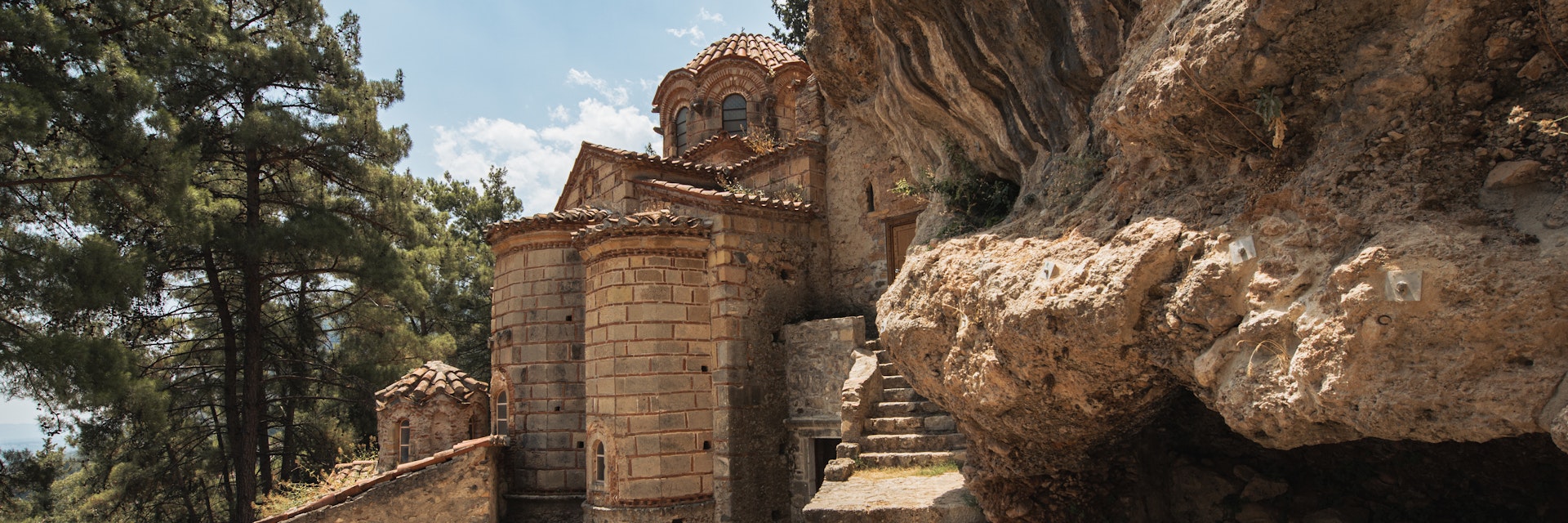Spread over a steep mountainside and surrounded by verdant olive and orange trees, this former Byzantine capital and fortified city is the single most compelling set of medieval ruins in Greece. Treading the cobblestones, worn smooth by centuries of footsteps, you can walk with the ghosts, ducking into the ruins of palaces, monasteries and churches, most dating from between 1271 and 1460.
History
The Frankish leader Guillaume de Villehardouin built the fortress in 1249. When the Byzantines won back the Morea from the Franks, Emperor Michael VIII Palaeologos made Mystras its capital and seat of government. Settlers from the surrounding plains began to move here, seeking refuge from the invading Slavs. From this time until Dimitrios surrendered to the Turks in 1460, a despot of Morea (usually a son or brother of the ruling Byzantine emperor) lived and reigned at Mystras.
While the empire plunged into decline elsewhere, Mystras enjoyed a renaissance. Gemistos Plethon (1355–1452) founded a school of humanistic philosophy here and his enlightened ideas, including the revival of the teachings of Plato and Pythagoras, attracted intellectuals from all corners of Byzantium. Art and architecture also flourished, as seen in the town's splendid buildings and frescoes.
Mystras declined under Ottoman rule, but thrived again after the Venetians captured it in 1687 and developed a flourishing silk industry. The population swelled to 40,000. The Turks recaptured the town in 1715 and from then it was downhill all the way; it was burned during the Orlov uprising in 1770 and Ibrahim Pasha torched what was left in 1825.
By the time of independence it was a largely abandoned ruin, and the refounding of nearby Sparta in 1834 contributed to the decline, though Mystras remained inhabited until 1953. Much restoration has taken place since the 1950s (and continues to this day) and in 1989 it was declared a Unesco World Heritage site.
Touring Mystras
At least half a day is needed to do justice to the ruins of Mystras. The site is divided into three interconnected sections – the kastro (the fortress on the summit), the hora (upper town) and the kato hora (lower town). The fortress (upper) gate is between the kastro and the hora, while the lower gate is at the bottom of the kato hora.
The following route takes in some of the site's top highlights:
The fortress
From the upper-entrance ticket office, the right-hand path (signposted ‘Castle’) leads up to the fortress; it's a 10-minute ascent. The fortress was built by the Franks and extended by the Turks; the views of the Lakonia plain, spread out below, are nothing short of fantastic.
Agia Sofia
The left-hand path descends from the ticket office to Agia Sofia, which served as the palace church and burial ground for several emperors' wives; some frescoes survive in a side chapel, including a well-preserved Birth of the Virgin Mary over the doorway. Steps descend from here via the church of Agios Nikolaos to a T-junction.
Convent of Pantanassa
Head right, through the Monemvasia Gate, the former entrance to the lower town, and on to the well-preserved 14th-century Convent of Pantanassa. Featuring a beautifully ornate stone-carved facade, it is still maintained by nuns, Mystras’ only inhabitants besides the motley crew of stray cats. The convent is an elaborate, perfectly proportioned building that's never overstated.
The exquisite, richly coloured 15th-century frescoes here are among the finest examples of late-Byzantine art. Look out for the tiny stamped silver and gold votive offerings beneath the large icon of the Virgin. You’ll find images of eyes, ears, legs, arms, breasts, babies, husbands and wives stamped onto these small tablets, depending on the problems for which the faithful have come seeking aid. It's a continuation of a long tradition going back to Classical Greece and beyond. The nuns may provide wraps to cover your legs.
Monastery of Perivleptos
The path continues down, via an impressive mansion house, to the exceptional Monastery of Perivleptos, which is built into a rock and tucked away in a pine grove at the far end of the site. Inside, the 14th-century frescoes, preserved virtually intact, equal those of Pantanassa. It's an extraordinary place. The marble-floored church has a dome in whose centre you'll find the Pantokrator (depiction of Christ as the universal, all-powerful ruler) surrounded by the Apostles, and the Virgin flanked by two angels.
Mitropolis (Cathedral of Agios Dimitrios)
Continue down towards the Mitropolis (Cathedral of Agios Dimitrios), a complex of buildings enclosed by a high wall. The original church was built in the 1200s, but was greatly altered in the 15th century. The church stands in an attractive courtyard surrounded by stoas and balconies.
Its impressive ecclesiastical ornaments and furniture include a marble iconostasis, an intricately carved wooden throne, and a marble slab in the floor featuring a two-headed eagle (the symbol of Byzantium) located on the exact site where the last Byzantine emperor, Constantine XI, was crowned in 1449 (he died in battle during the fall of Constantinople in 1453). The church also has some fine frescoes. Exhibits at the small but modern museum upstairs include fragments of ancient cloth, buttons, jewellery and other everyday items.
Tickets and other practicalities
The ticket price to enter Mystras is €12. Entry to the site is free every first Sunday from November 1st to March 31st.
Aim to start early in the morning to beat the tour groups, wear comfortable shoes and bring water (you can refill at the convent).








